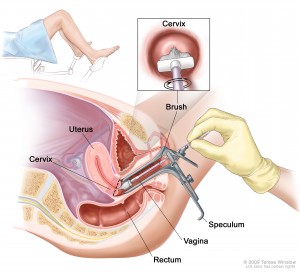Test Pap is the microscopic examination of cells that are scrapped from the cervix of uterus. It is a diagnostic examination for for the diagnosis of cervical cancer. (The cervix is the more inferior part of uterus that appears at the top of the vagina).
Procedure
You will be asked to lay down in a gynecologic table and place your legs οn the metallic brackets. The nurse will import an hysteroscope inside the vagina and will open it gently in order to check the interior of the vaginal canal. The cells are scrapped softly from the region of cervix and are sent to the laboratory .
Prepara tion
tion
You must inform your doctor if:
You take other medicines or contraceptive pills
You had an abnormal previous test Pap
You may be pregnant
24-hours before the test you must avoid :
Vaginal washes
Sexual contact
Shower
Use of tampon
Avoid the planning of Pap test, while you:
Ηave your menstrual period, because it can influence the precision of the test.
If you experience any abnormal bleeding, the doctor can still recommend you to make the test.
Note that you should empty your bladder little before the test.
What you are going to feel during the test process
Pap test may cause some discomfort to you, similar to menstrual pains. You may also feel a small pressure during the procedure, or experience a slight bleeding after the test.
Normal Results
A Regular (negative) test means that abnormal cells do not exist at the moment.
Note: normal grade can differ lightly among various laboratories. Discuss with your doctor as regards
to the significance of the particular results of your test.
Abnormal results are grouped as follows:
ASCUS or Agus (atypical cells of unspecified importance): These changes may be due to HPV infection, but may also mean that precancerous changes are present..
LSIL (low degree malformation), or HSIL(high degree malformation): This
means that precancerous changes are likely to exist. The danger of cervix cancer is greater with HSIL.
Carcinoma in situ (CIS): This usually means that abnormalities are likely to convert into cancer.
Atypical squamous cells (ASC-H): This means that the abnormal changes that have been found, are likely to be HSIL.
Atypical glandular cells (AGC): In this case changes of the cells which refer to precancerous stages of the superior part of the vagina or the interior of uterus.
When a test Pap shows unusual changes, it is essential that a further control or follow-up is performed. The next step depends on the results of test Pap, on your previous background, as well as the risk factor you may have for cervix cancer.
This control may include:
Colposcopy-directed biopsy
An HPV -test , to test the presence of types of HPV virus that are more likely to cause cancer.
For small changes of cells, the doctors usually recommend that test Pap be repeated in 3-6 months.
Assessing or the outcome
Pap test is not 100% precise. The cervical cancer can be perceptible in a small number of cases. Fortunately, cervical cancer is for most women a slow –growing cancer and the follow-up Pap test can detect worrying signs in the duration of time, which can be treated effectively. Make sure that your doctor is informed about the medicine that you take. Some of them, including the estrogens and the progesterone, can affect the result of your Pap test.





